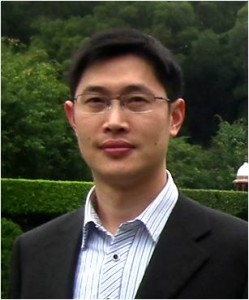 Prof. Chao Gao received a B.S. in 1995 and a M.S. in organic chemical engineering in 1998 from Hunan University, and a Ph.D. in polymer chemistry and physics under the supervision of Prof. Deyue Yan in 2001 from Shanghai Jiao Tong University (SJTU). Then he became a faculty member in SJTU and was promoted as an associate professor in 2002. Since Nov. 2003, he worked with Prof. Sir Harry Kroto as a visiting scholar and post-doc research fellow in the University of Sussex, UK. Afterwards he moved to Prof. Axel H. E. Müller’s group at Bayreuth University, Germany in July 2005 as an Alexander von Humboldt fellow. In 2008, he joined the Department of Polymer Science and Engineering, Zhejiang University and was promoted as a full professor. His research interests include hyperbranched and other dendritic polymers, chemistry of graphene and carbon nanotubes, controlled/living polymerization and click chemistry. He co-edited (with Prof. Deyue Yan and Prof. Holger Frey) a book, Hyperbranched Polymers: Synthesis, Properties, and Applications (published by John, Wiley & Sons), and published more than 90 papers with citation of more than 3500 times. His research result of graphene fiber knot has been selected by Nature as “Images of the Year” in 2011. He is the advisory editorial member of Colloid and Polymer Science.
Prof. Chao Gao received a B.S. in 1995 and a M.S. in organic chemical engineering in 1998 from Hunan University, and a Ph.D. in polymer chemistry and physics under the supervision of Prof. Deyue Yan in 2001 from Shanghai Jiao Tong University (SJTU). Then he became a faculty member in SJTU and was promoted as an associate professor in 2002. Since Nov. 2003, he worked with Prof. Sir Harry Kroto as a visiting scholar and post-doc research fellow in the University of Sussex, UK. Afterwards he moved to Prof. Axel H. E. Müller’s group at Bayreuth University, Germany in July 2005 as an Alexander von Humboldt fellow. In 2008, he joined the Department of Polymer Science and Engineering, Zhejiang University and was promoted as a full professor. His research interests include hyperbranched and other dendritic polymers, chemistry of graphene and carbon nanotubes, controlled/living polymerization and click chemistry. He co-edited (with Prof. Deyue Yan and Prof. Holger Frey) a book, Hyperbranched Polymers: Synthesis, Properties, and Applications (published by John, Wiley & Sons), and published more than 90 papers with citation of more than 3500 times. His research result of graphene fiber knot has been selected by Nature as “Images of the Year” in 2011. He is the advisory editorial member of Colloid and Polymer Science.
What was your inspiration in becoming a chemist?
To become a scientist is my childhood dreams, with the encouraging stories of those big masters such as Albert Einstein, Marie Curie and Alfred Nobel. When I went to high school, chemistry is my most favorite and best subject, under the special guidance and inspiration of the chemistry teacher, Mr. Changliang Zheng. Therefore I chose chemistry as my major in the university. My potential in scientific research was found when I became a Ph.D. student of Prof. Deyue Yan and I got the Award of National Excellent Doctoral Dissertation of China. After graduation, I was happy to become a faculty member in the College of Chemistry and Chemical Engineering, Shanghai Jiao Tong University.
What was the motivation to write your Polymer Chemistry article?
Hyperbranched polymers are a very interesting topic to be addressed due to their three-dimensional topology and unique properties. Their multifunctional groups can be used as a versatile platform to make promising materials. However, the functional groups of conventional hyperbranched polymers (CHPs) are too compact to be modified completely (generally 60-70% conversion of functional groups) due to the closely branched units. So we designed and synthesized segmented hyperbranched polymers (SHPs) with sparsely branched units. We found that the functional groups of SHPs can be modified completely (~100% conversion) despite the density of functional groups is extremely high (1-3 groups per unit). Moreover, the heterofunctional groups can be readily and orthogonally functionalized with different blocks, paving an avenue toward multifunctional smart materials.
Why did you choose Polymer Chemistry to publish your work? (DOI:10.1039/C2PY20951A)
I like polymer chemistry, especially the synthesis of new polymers with novel architecture even though they seem useless in industry at this moment. I think Polym. Chem. is an ideal platform for showing such structures and unique properties.
In which upcoming conferences may our readers meet you?
I will attend the 10th IUPAC International Conference on Advanced Polymers via Macromolecular Engineering, August 18th – 22nd 2013, Durham University and the China Polymer Conference in October 12-16th, Shanghai.
How do you spend your spare times?
I like to spend my spare time with my family. Besides, I enjoy sports, especially playing tennis and watching tennis grand slam.
Which profession would you choose if you were not a scientist?
Maybe I would be a journalist or TV presenter.










